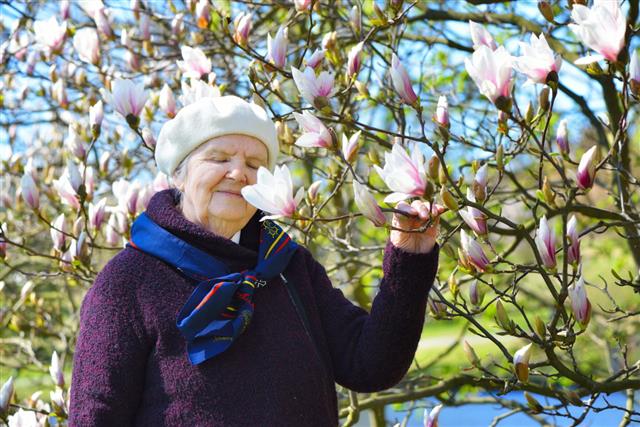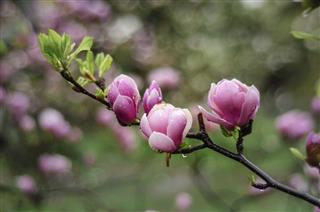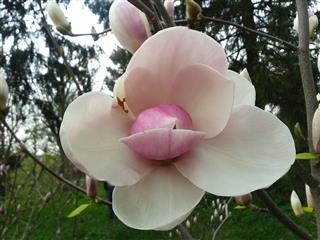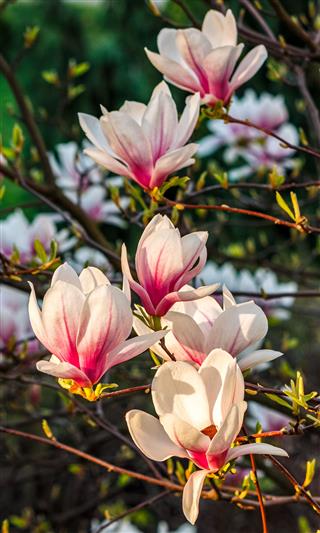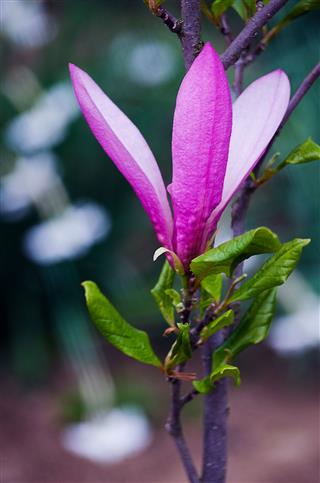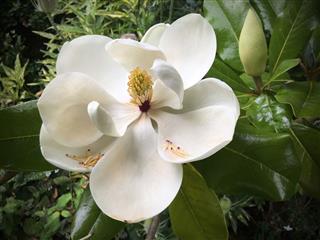
Most of the magnolia species are tough and sturdy, but sometimes they too develop diseases. Even pest attacks are not uncommon in these trees.
There are around 200 species of magnolia trees that are mainly used for landscaping. Popular for their lovely spring blossoms, these trees are also fairly resistant to diseases and pests. However, this does not mean that they are completely immune. Magnolia trees may develop diseases like bacterial or fungal leaf spots that may worsen to leaf blight, verticillium wilt, sooty mold, powdery mildew, etc.
Symptoms: Purple/Gray/Black Leaf Spots, Leaf Discoloration
POSSIBLE CAUSE: FUNGAL LEAF SPOT DISEASE
Identification Tips: Magnolia trees can be infected by different types of fungi and the most common among them are the species of Septoria, Phyllosticta, Coniothyrium, etc. The symptoms may vary slightly with the causal agent. The condition is characterized by leaf spots, that could be in the shades of gray, yellow, brown, red, purple or black. While some fungi cause formation of leaf spots with dark margins, others grow as concentric rings. In case of heavy infestation, the leaf spots merge to form large dead areas and the condition is then called leaf blight. In some cases, the center of the spots could be white or may develop shot holes. The leaves may turn yellow or brown and fall off. In some trees, the petioles, stems, flowers and even fruits develop such fungal spots.
Causes: The most common cause is the fungi that survive in the debris of affected trees. They produce spores during spring and summer and the spores are carried by rainwater, wind and even insects. Once the spores settle on a magnolia, they germinate and grow, as and when the conditions become favorable. So magnolia trees that are in wet, shady and humid locations are at the risk of developing fungal leaf spots. Crowded planting could as also be a contributory factor. Though mild infection may not harm the affected tree, heavier and repeated episodes along with premature leaf dropping may affect its growth.
Control and Prevention: First of all, prefer disease-resistant varieties while planting magnolia. Avoid watering the foliage and prune infected and weak branches. Dispose the residue and disinfect the tools. Fungicidal sprays may work as a preventive measure. Fungicides may prevent secondary infections, in a tree that is already infected with fungus. Use fungicides as per the instructions of a horticulturist. If the tree has a dense foliage, pruning will facilitate air circulation, which will be beneficial for preventing such infections.
Symptoms: Brown Leaf Spots, Leaf Dropping, Stem Tip Dieback
POSSIBLE CAUSE: BACTERIAL LEAF SPOT DISEASE
Identification Tips: Bacterial leaf spot disease is characterized by brown, angular spots that develop along the leaf veins. In some cases, a yellow halo may be found around these leaf spots. As the infection spreads, the spots merge to form large lesions that wither from the center. Thus the leaves develop irregular holes and also get curly, torn, tattered and distorted. Premature dropping is also seen. Other symptoms include vein darkening, blossom or stem tip dieback and stem cankers that ooze a gummy liquid. When the leaf spots merge and form large necrotic areas, the condition is called leaf blight.
Causes: As compared to fungal leaf spots, bacterial leaf spots are not common in magnolias. The bacteria (like Pseudomonas syringae) that cause leaf spots or blight are usually found in the debris of diseased trees. They get transmitted through wind, water or contaminated soil. They require entry points in the form of wounds, scratches or abrasions on trees. They may also enter through the natural pores on the tree. Once they gain entry, the bacteria spread rapidly and the whole tree may wilt and die.
Control and Prevention: If the condition is limited to leaves and small branches, then prune and dispose them properly. Don’t forget to disinfect the pruning tools. If the main stems develop cankers, then the condition is systemic and there is no point in pruning. In such cases, remove the tree completely. You can prevent the condition by choosing disease-resistant cultivars that have to be planted in locations with enough sunlight and air circulation. Minimize overhead watering and opt for mulching. Make sure that pruning is done during dry conditions.
Symptoms: Greenish-Gray Spots on Leaves
POSSIBLE CAUSE: ALGAL LEAF SPOT
Identification Tips: The condition is characterized by greenish-gray spots on leaves. The spots are roughly round with wavy margins. During summer, the spots may turn reddish-brown and velvety as they produce spore-producing structures. Heavily-affected trees may develop discoloration and premature dropping of leaves. In some cases, even the twigs, flowers and fruits develop such spots. The tree may die eventually, if the algae enter the branches through cankers. Sometimes, certain types of fungi may also colonize the algal spots.
Causes: So this is a magnolia tree disease that is caused by parasitic algae named Cephaleuros virescens. The spores of the algae are produced during summer and are dispersed during rains or by wind. This condition mainly affects the weak and slow-growing magnolias that grow in poor soil conditions. Excessively wet and moist leaves are vulnerable to algae attack. Humid conditions boost the growth of such algae on magnolia trees.
Control and Prevention: Remove infected parts from the tree and dispose them properly. Disinfect the pruning tools. In case of severe infection, copper fungicides can be used as per the instructions of a horticulturist. Make sure that your magnolia tree is getting enough sunlight, water and fertilizer. Healthy trees are not usually found to develop algae spots. Apart from that, improve air movement by pruning the dense foliage. Avoid overhead watering.
Symptoms: Wilting of Leaves and Branches, Discolored Sapwood
POSSIBLE CAUSE: VERTICILLIUM WILT
Identification Tips: As the name rightly suggests, the most common symptom is wilting of the leaves and branches. Initially, the leaves turn yellowish with brown margins and develop a scorched look. In magnolias, the sapwood develops a brownish stain, when a tree is infected with this fungus. While some of the affected trees die slowly after several years, in some others death due to verticillium wilt is much more rapid.
Causes: Verticillium wilt is one of the common magnolia tree diseases and is caused by certain types of fungi named Verticillium dahliae and Verticillium albo-atrum (the former is more common). These fungi can live in soil for indefinite periods, in a dormant state. When they come in contact with the roots of weak and stressed out trees, the fungi germinate and infect them. The infection spreads through the vascular system of the tree, thereby blocking movement of water and nutrients. This may lead to a rapid or slow death of the infected tree. Deficiency of certain nutrients could make magnolia trees prone to this condition. It has also been suggested that nutrients in excess could be a contributory factor.
Control and Prevention: As the fungi can live in soil for very long duration, it is difficult to eradicate them completely. If a magnolia tree develops this condition, remove the infected branches and burn them, along with the debris. There are chances that the infected trees regain its growth and outgrow the disease. It is always advisable to remove dead trees completely and sterilize the soil, before replanting. Make sure that the cultivars used for replanting are resistant to this disease. Ensure that they are fertilized properly.
Other Diseases in Magnolia Trees
- Black Sooty Mold: Though not a harmful disease, sooty mold is the fungal growth on the leaves and stems of magnolia trees that are infested with pests like scales and aphids. These pests secrete a sticky substance (called honeydew), on which a black-colored, velvety fungus grows. Though the condition does not kill the tree, it can interfere with its growth process (affects photosynthesis), if the fungus covers the entire stems and leaves. Timely pest control is the golden rule, if you want to get rid of this fungus. Once the infestation is dealt with, wash off the mold with water.
- Powdery Mildew: This condition is also caused by fungi and is characterized by white powdery patches on leaves and stems. In most cases, powdery mildew is not found to be harmful for the tree. However, it can cause distortion of leaves, premature leaf dropping and deformation of buds and flowers. Apply fungicides as soon as you notice the symptoms. Avoid overhead watering and remove the infected leaves. Proper air circulation and a good amount of sunlight will be beneficial.
- Wood Rot: Another fungal disease in magnolia trees, wood root causes decay of the wood. The symptoms may vary with the type of fungus that affects the tree. The fungus enters the tree through wounds or scars. The disease is identified by the fruiting fungal bodies (called conks) that develop on the trunk of the affected tree. Wood rot is usually seen in older trees and can lead to their death. So protect your magnolia tree from injuries. Remove diseased and dead branches and dispose them properly.
This is only a brief overview about some of the common magnolia tree diseases. Apart from those mentioned above, there are various other conditions that can be caused by climatic and soil conditions (like sunscald and frost cracking). Even pests like scales, thrips, beetles, weevils, root borers and ants can infest these trees and affect their growth. So choose disease-resistant varieties of magnolias, while planting. Provide them with ideal conditions for healthy growth. Adopt preventive measures and check for the symptoms. Timely treatment is required to save your tree from damage.

